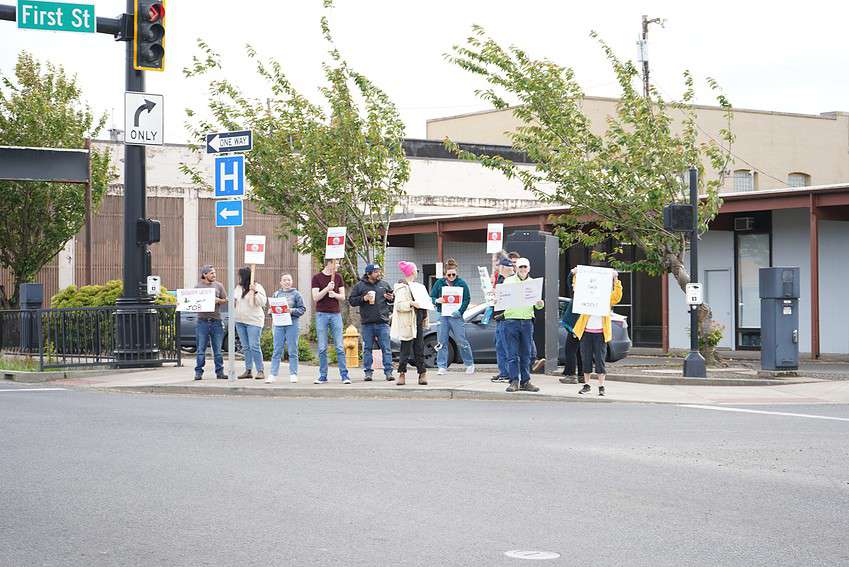Jacob Van Buskirk, a Tillamook County resident and member of several progressive organizations, is on a mission. His goal? To ensure that Suzanne Weber, a local legislator, returns to work and fulfills her duties on the Senate floor.
Van Buskirk is not alone in his concerns. Residents who share his frustration rallied for the cause on Tuesday, May 23.
“There are numerous bills that need to be voted on and only a month left in the legislative session,” said Van Buskirk.
The community’s discontent was made clear last November when a new law was passed stating that ten absences from the Senate floor were enough. Weber, however, has already exceeded this limit with twelve absences.
Despite the clear message from the community and the constitutional backing of the law, Weber continues to abstain from her duties. This has led to a halt in the democratic process, with a small minority effectively preventing the entire government from functioning.
Van Buskirk points out that the legislators’ job is to participate in the process, whether that means improving bills they disagree with or voting against them. This is how democracy functions, and it’s how they register their vote. If people agree with them, they can elect more individuals who share their views.
The lack of clarity from the Republicans, including Weber, has added to the frustration. While it’s assumed that they’re protesting the gender-affirming care bill, no specific bill has been clearly stated as the cause for their walkout.
In Van Buskirk’s view, the democratic process should be respected and followed. He believes that systematic changes, such as ranked-choice voting and other democratic reforms, could improve the process. However, until such changes are made, the existing rules should be adhered to.
Van Buskirk also notes that the democratic process is functioning in other states, even when laws are passed that some disagree with.
“You don’t see Democratic senators walking out or violent protests occurring,” he said, adding, “people follow the process, and laws get passed – a testament to the functioning of democracy.”
However, the situation in Oregon’s Senate paints a different picture. The Senate is currently in a state of turmoil due to a boycott by Republican senators. Six more senators have joined the walkout, bringing the total number of boycotting GOP senators to 10. This action has paralyzed the state government as the Senate has been unable to reach a quorum, leading to a gridlock.
The senators involved in the walkout have reached their 10th unexcused absence from the session, which disqualifies them from serving their next term under Senate rules. The Republicans claim their protest is due to the “readability” of several bills currently up for debate, but Democrats argue that the walkout is an attempt to prevent these bills from passing. The bills in question concern issues such as abortion, gender-affirming health care, and gun control.
Senate President Rob Wagner expressed his disappointment with the situation, stating that the walkout must end as it shakes people’s faith in Oregon’s democracy. He also mentioned that the legislature has never had to deal with a situation where members were constitutionally barred from seeking re-election. Despite the ongoing crisis, Wagner has stated that he will not convert any of the Republican senators’ unexcused absences to excused as part of the negotiations.
The events in Oregon’s Senate and Van Buskirk’s mission highlight the importance of participation in the democratic process and the potential consequences when it is disrupted.
The Greater Idaho movement is an initiative that aims to relocate the Oregon/Idaho state line to better reflect the cultural divide in Oregon. The movement argues that state lines have been relocated many times in American history and that the current Oregon/Idaho line, established 163 years ago, is now outdated. They propose that counties should have the opportunity to become part of Idaho, a change that would require an interstate compact between the two state legislatures and approval from Congress.
The Greater Idaho movement believes that this proposal is a win-win situation for all parties involved. They argue that it would benefit the counties switching states, the state legislatures, and the residents of both states. Unlike creating a new state, this proposal would not affect the balance of power in the US Senate, making it more likely to be approved by the Oregon Legislature.
The movement has gained traction among both conservatives, who wish to be part of a red state, and progressives in northwestern Oregon, who welcome the idea of a smaller Oregon. The initiative also includes support from residents of Idaho, California, and Washington.
Incorporating this into the larger narrative, the Greater Idaho movement presents another facet of the complex political landscape in Oregon. While some citizens, like Jacob Van Buskirk, are advocating for increased participation in the democratic process and adherence to existing rules, others are pushing for a reevaluation of state lines to better reflect cultural divides. These differing perspectives highlight the multifaceted nature of democracy and the various ways citizens engage with and seek to influence their political environment.
The current walkout in Oregon’s legislature is the tenth in the state’s history, with some previous walkouts being less dramatic than others. The tactic of walkouts is typically used by the minority party as a stall tactic to kill specific legislation. The Senate and House can’t hold votes unless a quorum, meaning at least two-thirds of each chamber’s members, is present.
The Democrats hold the majority in both the Senate and the House, but they can’t achieve a quorum in either chamber on their own. If enough Republicans walk out, business grinds to a halt. Oregon is one of only a few states that require more than a simple majority for a quorum, and the state has faced several walkouts in the past.
The recent Republican walkouts in Oregon led to discussions among Democrats about lowering the quorum threshold. However, a grassroots campaign eventually led to Measure 113 being put on the ballot, which created penalties for walkouts. Oregon voters passed the measure by a more than two-to-one margin last year. Lawmakers with 10 or more unexcused absences in a single legislative session will now be barred from running for the legislature or holding a legislative seat in the next term.
The current walkout appears to be the first test of the new rules, although it remains to be seen whether it will last long enough to trigger the penalties for a 10-day absence. There are still more than 8 weeks left in the session.
June 2001: Redistricting – House Democrats walked out for 5 days in response to Republicans attempting to pass their redistricting plan as a resolution rather than a bill, in an attempt to dodge a veto from Democratic Gov. John Kitzhaber. The Democrats stayed away past a deadline for the legislature to take action on redrawing district maps, resulting in the task being kicked over to the secretary of state.
April 1995: Protest over award – Some Senate Democrats walked out in protest after Republicans abandoned an award named for a former Democratic state senator. The walkout lasted for 1 day.
Additionally, there was a walkout in 1971 by both House and Senate Democrats, but the cause of the House walkout was unknown. The Senate walkout was prompted by Republicans refusing to consider a federal constitutional amendment to lower the voting age. Each walkout ended within a day.
The frequency of walkouts has undeniably increased from 2019 onward, but the use of the tactic in Oregon dates all the way back to 1971. The walkouts have been instigated by both Republicans and Democrats, and have targeted a range of legislation, from redistricting to education funding to COVID restrictions. The outcomes of these walkouts have varied, with some resulting in the targeted legislation being passed, others leading to the legislation dying, and some having no lasting impact.
The future implications of the 2023 Republican walkout in Oregon’s legislature could be significant and multifaceted, affecting both the political landscape and the legislative process in the state.
Legislative Impact: The immediate impact of the walkout is the stalling of legislative business. With numerous bills awaiting votes, the walkout could delay or even prevent the passage of important legislation. This could have long-term effects on the state, depending on the nature of the stalled bills.
Political Consequences: The walkout could have serious political repercussions for the involved lawmakers. Under Measure 113, which was passed by Oregon voters, lawmakers with 10 or more unexcused absences in a single legislative session are barred from running for the legislature or holding a legislative seat in the next term. If the walkout lasts long enough to trigger these penalties, it could lead to a significant shakeup in the state’s political landscape.
Public Perception: The walkout could also influence public perception of the Republican Party in Oregon. Depending on how the situation is handled and resolved, it could either bolster support for the party among its base or lead to a backlash, particularly if the walkout is seen as obstructing important legislation.
Potential for Reform: The walkout could lead to further discussions about reforming the legislative process in Oregon. This could include changes to the quorum requirements, the implementation of penalties for walkouts, or other democratic reforms.
Influence on Other States: The walkout and its aftermath could also influence similar situations in other states. If the penalties under Measure 113 are enforced, it could deter lawmakers in other states from using similar tactics. Conversely, if the walkout is successful in achieving its goals, it could encourage lawmakers in other states to consider similar tactics.
Check out a video interview of the rally leader here:


